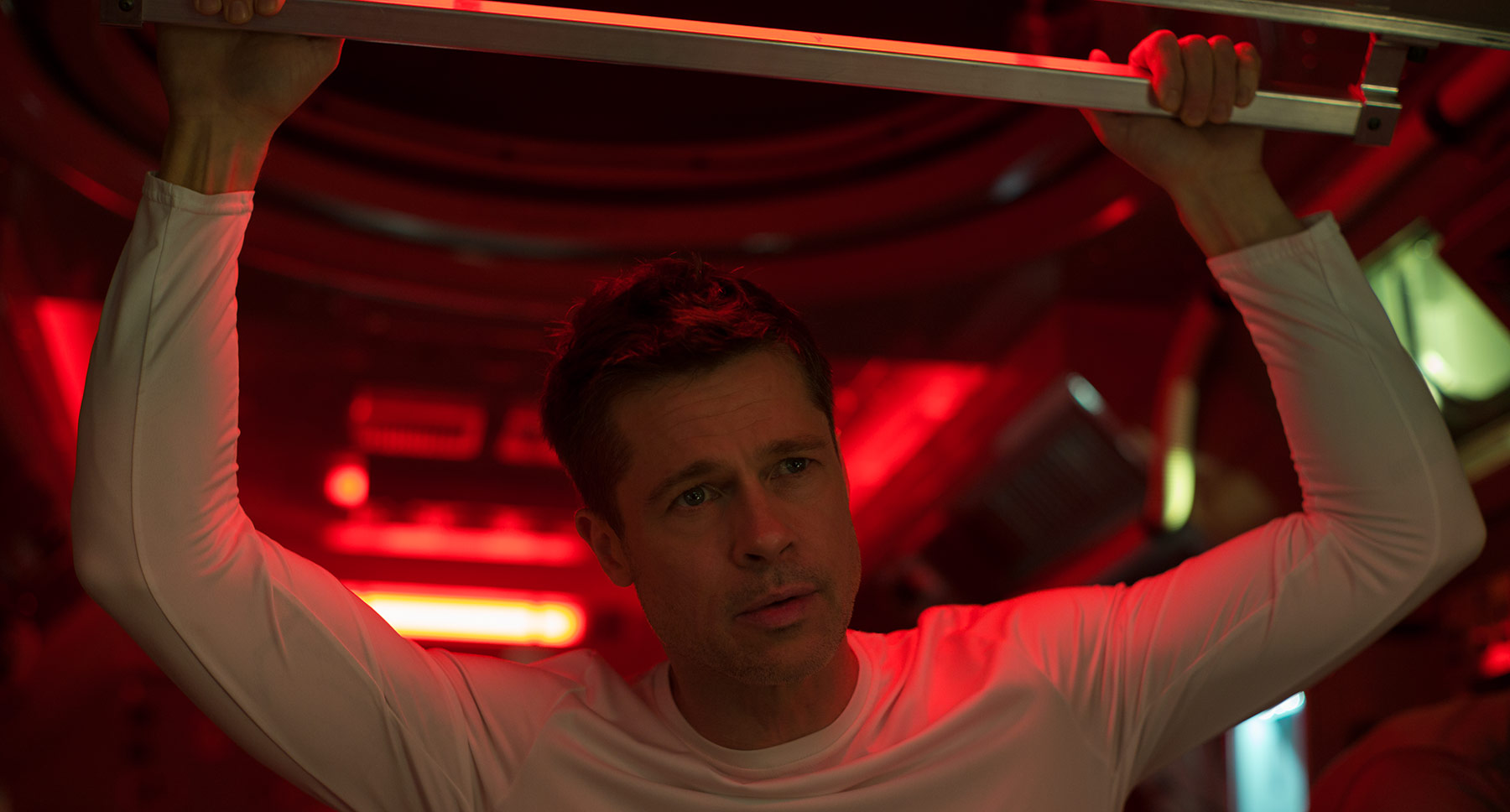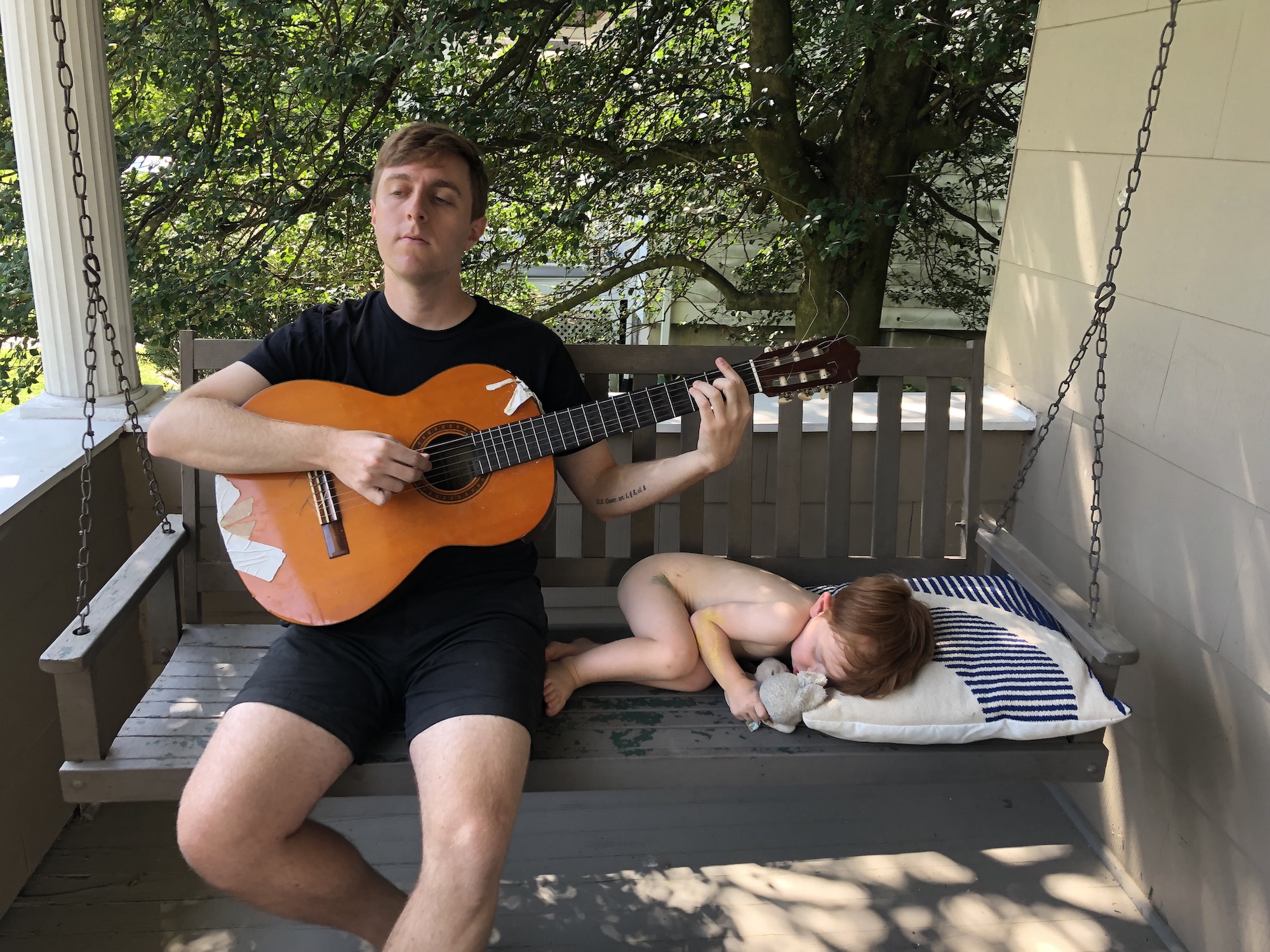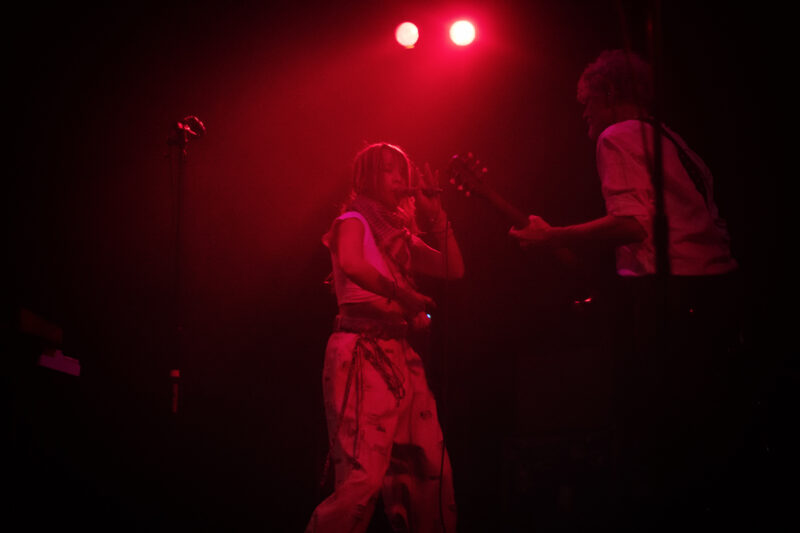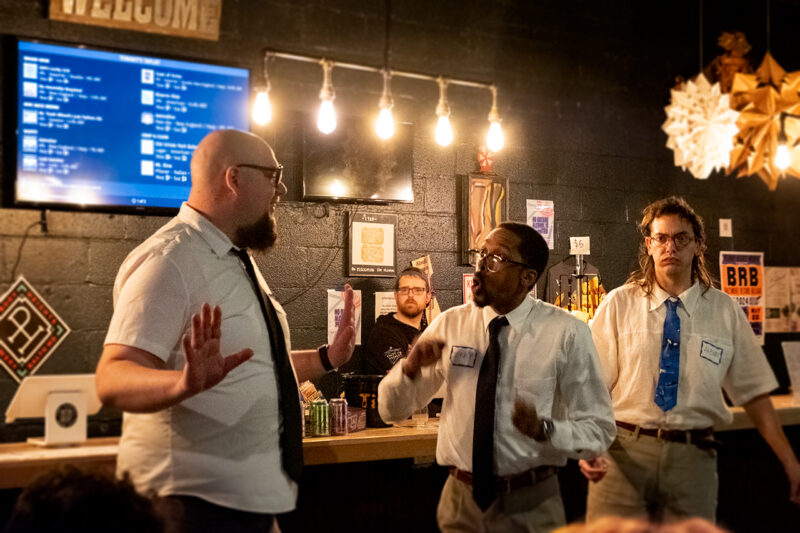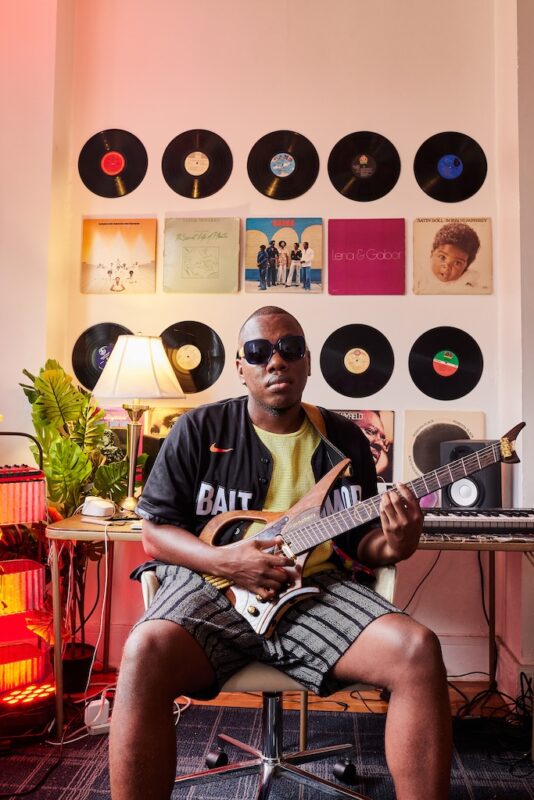Everything’s liquefying my brain. I’m trying to limit the mind-numbing time that I spend on the internet where the day-to-day galaxy-brain discourse makes it impossible for people to pull apart nuance from complicated ideas. Feels like even my sentence formulation is askew and self-sense is chameleonic because I have pretty much always been extremely online. It’s maybe affecting my vision; lately I mix up words in the middle of reading or typing them, like the other day when I got “adequate” confused with “aqueduct.” Anyway, every week I thank a god I am unsure about that I am able to go to therapy, where I can push against the black-and-white and nestle into the myriad gray areas that abound in work and life and the world. And try to get out of my own head.
Before I even gave the latest record by Adam G Holofcener a listen, I noticed on the liner notes of the album’s Bandcamp page a short, wise piece of advice: “GO TO THERAPY.” The album, Everything’s Ostensible, wrestles with parenting and fear, white privilege, economic inequity, and what to do about the rich people on Gibson Island, among other such goliath problems that can make one feel immobilized and useless. Holofcener seems bent on pushing against that feeling by making music and sound art—individually and, crucially, collaboratively in public. (In addition to this multifaceted art practice, he is also the Executive Director of the Maryland Volunteer Lawyers for the Arts, which provides pro bono legal services to artists.)
The complicated, dynamic modes of this record signaled to me a kind of therapeutic working-through-it. When I ask Holofcener about this one day over coffee, he tells me that about 80 percent of these songs were already written and recorded before he started going to therapy about a year ago. Reflecting on it after so much committed cognitive work, he laughs and says that some of the songs actually sound like cries for help now. In therapy, one of the first things he started to work on was black-and-white thinking, a cognitive distortion that makes it hard to compartmentalize, to articulate or grasp nuance, or to compromise, resulting in a genuine struggle to generally feel okay about yourself and your choices.
Black-and-white thinking is not only personally torturous but can also be socially stultifying. Pre-therapy, every single decision had become an ethical and moral one. “I couldn’t listen to Spotify, because it treated musicians so poorly,” Holofcener says. “I couldn’t do anything. It was sort of just like everything was a red line I felt like I was crossing every day in my life.”

Adam G Holofcener’s Everything’s Ostensible, image by Wallace Pyne Holofcener
Holofcener has become a “therapy evangelist” over the last year. It only took him about 10 minutes into his first session to realize the work ahead of him would be worth it. “I’ve never felt more on track to continue to be approaching the person that I want to be, without even knowing that that was possible,” he says.
He speaks in the helical way of someone with about a million things running through their mind all the time, full of asides and qualifications and long anecdotes and caution and quickness. This is totally mirrored in the mood of Everything’s Ostensible, with songs that ponder generational intra-family conflict, parenting, the deep state, and in one or two places, what it means to do what’s right—and what even is right and what the hell can even be done. There’s an underlying squabble with urgency and a seesawing between hope and dread, mingling and embattled with a variety of musical styles, from down-home folk twangs to noisy-jam poetic interludes to haunted-carnival-nightmare ragas.
But, well, those are really just the knottier aspects of the album, the anxiety-inducing qualities of the songs, which my brain—liquefying, as I said earlier—latched onto ‘cause that’s where she’s at these days. It is not all woe. It does contain wisps of what makes us uneasy, but it also exhibits a real joy and a blissful buzz and meditating calm all at once, too.
In “District Waltz,” a recording of the bubbly, joyous sounds of Holofcener’s wife Margot giving their child Wally a bath provides background to a lullaby-like song that reasons through working for the deep state and what that means these days:
Mama goes down
To the district town
Every day in the morn
‘Cause she is the law
And she ain’t got no flaws
And does right by whom she can
The same can’t be said
For all of the heads
Who work in the capital
They are obliged
To watch people die
And make sure the world goes turn
The lyrics go on as an indictment of those capital heads dedicated to the status quo in their idea of liberty—”even if the sky rain down blood/ you’ll let the bells ring”—making the docile waltz the ideal form for the song. Wally’s squealy laughs act as a buoyant outro, evening out some of that lyrical worry, no room for nihilism.
Wally, who as a 2-year-old made the album’s beautiful, Joan Mitchell-esque cover art, a tangled bale of white cutting through a red background, appears indirectly throughout the album. “I’m not tied to your outcomes, or so I say/ Cognitive dissonance, all the way,” Holofcener reasons in the album-closing, slow-going “Poly,” which dreams up a joke-y future scenario when Wally’s grown, and relationship structures like a “polyamorous robot menage” are the norm, maybe, and as a dad Holofcener’s gonna have to find a way to navigate that and be cool with it even if he doesn’t really understand it. “I felt obliged to try and think so far into the future, about how they were potentially going to feel about all my myriad inequities that I’m effectuating today, and then how they’re going to go through that, but how they’re stymied by their sort of intergenerational traumas and histories,” he tells me.

Holofcener performing with Jeremy Lyons at Black Cherry Puppet Theatre in October 2018 (Photo by Margot Kniffin)
Although making art, for Holofcener, is kind of therapeutic, it assuredly isn’t, either. It’s more that he just can’t not make these songs. “The only way I can describe whether it’s therapeutic or not is like, I’m obliged to do it,” he says. “If I wasn’t able to do it, it would be so deleterious towards me.” This is why the art-making is only a piece of the whole process: Making songs with a certain level of consciousness about pressing issues of injustice, for example, doesn’t get him to the “good place,” just to a baseline.
The song “Generations,” he says, is “clearly working through some stuff,” as a spoken-word-ish, parenting-anxiety manifesto pushing through fuzzed-out guitar. Writing and practicing his music in the studio over and over and performing is often therapeutic in some sense. “That all has sort of these blips of dopamine-kinda-hits,” he says, “but I worked through those issues in therapy in a way that had action items, and got somewhere and had resolution in a way that I’ve never really had with art.”
And of course, making a song, or writing a manifesto or an exposé or a thoughtful essay, won’t solve our social ills, but it can at least make the spotlight a little brighter. Holofcener is frustrated by individualism that creative practices often employ—even in ostensibly social/collective forms like music. Even when other musicians and artists have contributed to his work, he says, it still has mostly stemmed from an individualistic framework. He references one thread of Adam Curtis’ HyperNormalisation (2016), a nearly three-hour-long rabbit-hole of a documentary that tracks the democracy-dissolving financialization of the West, among other things, and how this has affected society and cultural production. “Everyone has been stuck in this zone that sort of makes collective organizing very hard, because there’s no focal point,” Holofcener says. “And even though everybody feels like we’re in the upside down, they don’t know what to do about it.”
Returning to Baltimore in 2014 after two years in LA sparked a shift in his creative practice, a conscious recognition that he wanted to consider “how to de-center myself in these types of creative processes in a more robust way.” For him, that has involved molding his creative practice into more publicly engaged forums, while still, of course, writing songs.

Greydolf performing at Upresting in April 2016 (photographer unknown)
Some performance projects over the last few years have taken shape as more communal, public-gathering acts. In April 2016, a year after the death of Freddie Gray and the Baltimore Uprising, he organized a workshop and performance series called Upresting, setting up four speakers in a vacant lot in Upton with a mic in the middle running a program he made “to turn one person’s voice into a protest.” What the mic picked up got “moved around and chopped up and delayed and refracted and multiplied and juiced up to make you feel like you are in the midst of a protest, but it’s only your voice.” The event was intended to be “a catalyst for conversation, community engagement, self-expression, and the mixing of folks who might not spend a lot of time around one another (especially in West Baltimore) given our apartheid-like city setup,” he wrote at the time.
In 2017, he and April Camlin organized a presentation of experimental sound artist Pauline Oliveros’ composition “Sonic Meditations” in conjunction with The Contemporary’s The Ground featuring the work of Michael Jones McKean. “Sonic Meditations” instructs a group in “deep listening” and intuitive sound-making—anyone can participate, no musical experience necessary. According to Oliveros’ instructions, this work can lead to “a tuning of mind and body.”
Holofcener likens the various components of creative labor and processing and therapy to a Thai massage, a very deep and apparently painful kind of massage. “[The practitioners are] like, No, your physiology demands that, like, all your shit’s in the wrong place, so I have to very intensely move it,” he says.
“When I’ve gotten it done,” he continues, “I’ve been like, Okay, this is tough stuff. But there’s this moment when they’re done, and they sort of put all your pieces back together. It’s the weirdest—at least for me, I’ve had this sensation like, Oh my god, I’ve arrived.”
The cassette release for Everything’s Ostensible is this Saturday, Sept. 28, at The Undercroft, featuring Adam G Holofcener and the Internet Jazz, Malaika + Naomi, Ernest Third & Mighty Mark.
Featured image: Adam Holofcener and Wally, August 2019. Photo by Margot Kniffin.
